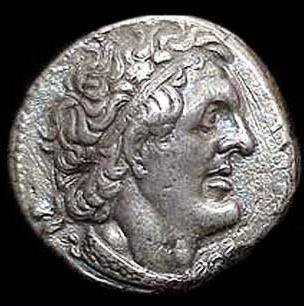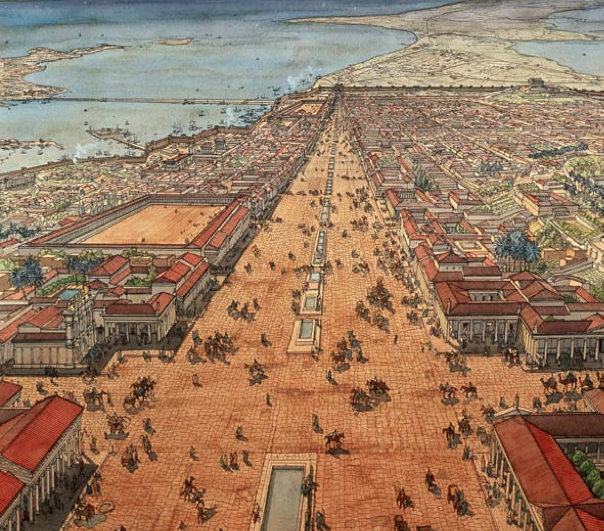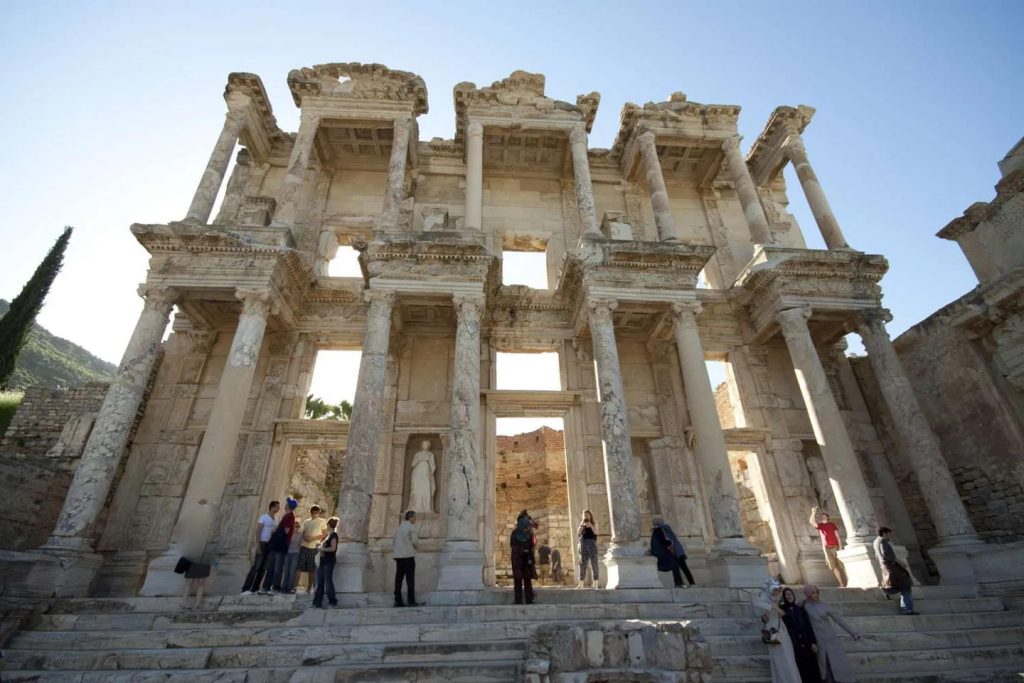Ptolemy I Soter: Architect of a cosmic archive
Ptolemy I Soter: Architect of a cosmic archive
- July 26, 2025
- 11:20 am
- István Csányi
In the swirling dust of Alexander’s crumbling empire, where generals carved kingdoms from conquest, one man dared to build something more enduring than bronze statues or marble palaces. Ptolemy I Soter, the Macedonian general who would become pharaoh, envisioned a monument not to military might but to the human mind itself. His creation, the Great Library of Alexandria, would become humanity’s first attempt to gather all knowledge under one roof – an audacious dream that would illuminate the ancient world for nearly seven centuries.

The story of how a battle-hardened soldier became history’s greatest patron of learning reveals much about the transformative power of vision. While his fellow generals fought over territory, Ptolemy fought for something far more precious: the collective wisdom of humanity. This is the tale of how one man’s extraordinary ambition gave birth to an institution that would fundamentally reshape how we understand knowledge, scholarship, and the very idea of a library.
From battlefield companion to philosopher king
Born around 367 BCE into Macedonian nobility, Ptolemy grew up in the shadow of greatness. As a childhood companion of Alexander the Great, he witnessed firsthand how a small kingdom could reshape the known world through military genius and cultural ambition. Yet unlike Alexander, whose legacy lay in conquest, Ptolemy’s true genius would emerge in the preservation and cultivation of knowledge.
During Alexander’s unprecedented campaigns across Asia, Ptolemy served as one of his most trusted generals, commanding troops through the Persian heartland and into the mysteries of India. But something remarkable happened during these journeys. While other generals collected gold and enslaved people, Ptolemy collected something far more valuable: exposure to the diverse intellectual traditions of the conquered lands. In Babylon, he encountered astronomers who had tracked the stars for millennia. In Egypt, he discovered medical texts that predated Greek civilization. In India, he glimpsed mathematical concepts that would take centuries to reach Europe.
These experiences planted seeds that would later bloom into an unprecedented vision. Ptolemy understood what many conquerors missed: that true power lay not merely in controlling territory but in commanding knowledge. This understanding would shape his approach to ruling Egypt and inspire the intellectual institutions he would found.
When Alexander died suddenly in Babylon in 323 BCE, his generals immediately began dividing his empire like hungry wolves over a carcass. The ensuing Wars of the Diadochi would rage for decades, as former brothers-in-arms became bitter enemies. Yet Ptolemy displayed a strategic brilliance that set him apart from his peers. Rather than grasping for the whole empire, he secured Egypt, wealthy, defensible, and home to an ancient tradition of learning that stretched back thousands of years.
His choice proved masterful. Egypt’s natural barriers – deserts to the west and east, the Mediterranean to the north – made it nearly impossible to invade. Its agricultural wealth from the Nile’s floods provided economic stability. Most importantly, its ancient culture offered something no newly conquered territory could: legitimacy through antiquity. Ptolemy understood that to rule Egypt effectively, he needed to become Egyptian while remaining Macedonian, to honor ancient traditions while introducing Hellenistic innovations.
Alexandria rises from ambitious dreams
The city of Alexandria itself embodied Ptolemy’s dual vision. Founded by Alexander during his brief stay in Egypt, the town remained little more than a planned settlement when Ptolemy assumed control. Under his guidance, it transformed into something unprecedented: a consciously designed metropolis where Greek and Egyptian cultures could merge and flourish together.

Ptolemy’s Alexandria was laid out with mathematical precision, its broad boulevards forming a grid that would inspire city planners for millennia. The famous Pharos lighthouse, one of the Seven Wonders of the Ancient World, began construction under his reign, its light promising safe harbor to merchants and scholars alike. The royal quarter, where Ptolemy established his palace, occupied nearly a third of the city – a vast complex that would soon house the institution that would outlive all his other achievements.
But Ptolemy’s vision extended far beyond impressive architecture. He understood that a truly great city needed more than monuments; it required minds. Through generous patronage and promises of intellectual freedom, he began attracting scholars from across the Mediterranean world. Mathematicians from Athens, astronomers from Babylon, physicians from Cos – all found in Alexandria something unavailable elsewhere: resources, respect, and the revolutionary idea that knowledge itself was worth pursuing for its own sake.
The Museum, or Mouseion – a shrine to the Muses – represented Ptolemy’s most radical innovation. Unlike anything before it, the Museum functioned as the world’s first university and research institution combined. Scholars received stipends from the royal treasury, freeing them from the need to teach for pay or seek wealthy patrons. They dined together in common halls, debating ideas across disciplines. They had access to laboratories, dissection rooms, astronomical instruments, and botanical gardens. Most importantly, they had access to the growing collection that would become the Great Library.
Building humanity’s memory palace
The Great Library of Alexandria began not with a building but with an idea: that all human knowledge could and should be collected in one place. This breathtaking ambition – to create a universal library containing every book ever written – seems audacious even by today’s standards. In an age before printing presses, when every text had to be copied by hand, it appeared almost impossibly grand. While the goal of absolute universality may have been more aspiration than achievable reality, the scope of the library’s ambition was unprecedented.
The library’s development spanned generations. While Ptolemy I laid the conceptual foundation and began the collection, much of the library’s physical construction and systematic expansion occurred under his son, Ptolemy II Philadelphus, who inherited both his father’s throne and his passion for knowledge. This multigenerational commitment demonstrates how the library represented not just one ruler’s whim but a dynastic mission to position Alexandria as the world’s intellectual capital.
Yet Ptolemy pursued this vision with the same strategic brilliance he had shown on the battlefield. He established a royal decree that all ships entering Alexandria’s harbor must submit their books for copying. Scribes would duplicate these texts, keeping the originals for the library and returning the copies to their owners. However, ancient sources report that this process was sometimes reversed, with the library holding the originals. This policy, whether fact or legend reflecting the library’s ambitious reputation, demonstrated the extraordinary lengths to which Ptolemy and his successors would go to build their collection.
The acquisition methods grew increasingly creative and aggressive. Ptolemy’s agents scoured the Mediterranean world, purchasing entire private libraries and commissioning translations of essential works. He reportedly paid the enormous sum of fifteen talents to Athens for the right to copy the official state versions of the tragedies of Aeschylus, Sophocles, and Euripides. When Persian and Hebrew texts arrived, he commissioned teams of translators to render them into Greek, creating in the process new traditions of textual scholarship.
The physical infrastructure of the library matched its ambitious scope. While no contemporary descriptions of the building survive, later sources suggest a complex of reading rooms, lecture halls, and covered walkways connecting different sections. The main collection was likely housed in the Museum itself, with additional storage in the nearby Serapeum temple. Ancient sources provide varying estimates of the collection’s size, ranging from 400,000 to 700,000 scrolls at its peak. However, modern scholars debate these figures, which likely counted individual scrolls rather than unique works. Whatever the exact number, it represented the largest systematic gathering of written knowledge in the ancient world.

But the library was more than a warehouse of scrolls. Under Ptolemy’s direction, it became the world’s first true research institution. Scholars didn’t merely read existing texts; they edited, compared, and critiqued them. They developed the first critical editions of Homer, standardizing texts that had varied wildly in oral tradition. They created commentaries and glossaries, invented new systems of punctuation and accent marks, and established principles of textual criticism still used today.
Attracting the ancient world’s brightest minds
Ptolemy understood that a great library needed great librarians. His first appointment set the standard for all who followed: Demetrius of Phalerum, an exiled Athenian politician and student of Aristotle’s Lyceum. Demetrius brought not only his considerable learning but also the organizational principles of Aristotle’s school, creating systematic catalogues and acquisition policies that would guide the library for centuries.
The succession of head librarians reads like a who’s who of ancient scholarship. Zenodotus of Ephesus, the first official head librarian, pioneered the alphabetical organization of texts and created the first critical edition of Homer’s epics. Callimachus, though never head librarian himself, compiled the Pinakes, a 120-scroll catalogue that represented the first attempt at a comprehensive bibliography of Greek literature. His organizing principles – dividing works by genre, then arranging authors alphabetically with biographical information – established patterns libraries still follow today.
Under Ptolemy II Philadelphus, who continued his father’s work with equal enthusiasm, the library attracted Eratosthenes, the polymath who calculated the Earth’s circumference with stunning accuracy. The mathematician Euclid wrote his Elements in Alexandria, creating the foundational text of geometry that would remain standard for over two millennia. The physician Herophilus performed the first systematic human dissections there, revolutionizing anatomical knowledge.
These scholars didn’t work in isolation. The Museum’s communal dining halls and covered walkways fostered interdisciplinary exchange unprecedented in the ancient world. Astronomers consulted with mathematicians, physicians debated with philosophers, and poets drew inspiration from historians. This cross-pollination of ideas created innovations impossible in more specialized institutions.
The library’s influence extended far beyond its walls through an ambitious program of copying and dissemination. Texts corrected and edited in Alexandria became the standard versions throughout the Mediterranean world. The library’s scholars established principles of textual criticism, developed new mathematical notations, and created linguistic tools that standardized Greek across diverse regions. The library shaped not just what the ancient world read but how it read.
Where cultures converged and knowledge bloomed
Perhaps Ptolemy’s greatest insight was recognizing that actual intellectual progress required cultural exchange. The Great Library became humanity’s first genuinely multicultural academic institution, where Egyptian priest-scholars worked alongside Greek philosophers, Jewish theologians debated with Babylonian astronomers, and Persian texts were translated alongside Indian mathematical treatises.
This cultural synthesis produced extraordinary innovations. When Greek geometric thinking encountered Babylonian astronomical data, the result was a revolution in celestial mechanics. Egyptian medical knowledge, combined with Greek theoretical frameworks, advanced anatomy, and surgery beyond anything previously imagined. The famous Septuagint, the Greek translation of the Hebrew Bible commissioned by Ptolemy II, represented not just linguistic translation but cultural bridge-building that would profoundly influence Western civilization.
The library’s translation movement went far beyond religious texts. Ptolemy commissioned translations of Persian historical chronicles, Indian mathematical texts, and Egyptian magical papyri. These translations required more than linguistic skill; they demanded deep cultural understanding. Translators had to find Greek equivalents for concepts that didn’t exist in Hellenic thought, creating new vocabulary and sometimes new ideas in the process.
This multicultural approach extended to the scholars themselves. The library welcomed anyone with genuine expertise, regardless of origin. Manetho, an Egyptian priest, wrote his history of Egypt in Greek at the library, providing Greek-speaking audiences their first systematic account of pharaonic history. Berossus, a Babylonian priest, similarly created a Greek account of Mesopotamian history and mythology. These works, though now largely lost, provided crucial bridges between ancient civilizations.
The economic model Ptolemy established proved equally innovative. By providing state stipends to scholars, he created the world’s first professional academics – people whose job was to think, research, and write. This freedom from economic pressure allowed for long-term projects impossible under traditional patronage systems. Astronomers could undertake observations spanning decades. Editors could spend years perfecting critical editions. Mathematicians could pursue abstract theories with no immediate practical application.
Legacy illuminating the darkness of time
The Great Library’s influence rippled across centuries in ways Ptolemy could never have imagined. Long after the Ptolemaic dynasty fell to Rome, the library continued its mission. Roman scholars pilgrimaged to Alexandria to study. Early Christian theologians developed their doctrines in dialogue with their philosophical texts. Islamic scholars would later credit Alexandrian sources for preserving Greek wisdom through Europe’s Dark Ages.
Yet perhaps the library’s greatest legacy lies not in the texts it preserved but in the idea it embodied: that knowledge belongs to all humanity. Ptolemy’s vision of a universal library, where all human wisdom could be collected, organized, and made accessible, established principles that guide libraries to this day. Every public library, every university collection, every digital archive traces its conceptual ancestry back to Alexandria.
The tragic destruction of the library remains one of history’s most debated mysteries. Ancient sources attribute its decline to various causes – fires during Caesar’s siege, neglect during economic downturns, deliberate destruction by religious zealots, or gradual dissolution over centuries. The truth likely involves multiple incidents rather than a single catastrophic event. But focusing on its destruction misses the larger point. The Great Library of Alexandria succeeded in its deepest mission: it preserved and transmitted knowledge across cultures and centuries. Texts edited in Alexandria, ideas developed in its halls, and methods pioneered by its scholars shaped intellectual history for millennia.
Modern Alexandria bears few traces of Ptolemy’s great project. The original library’s location remains uncertain; its buildings long since vanished beneath urban development. Yet in 2002, the new Bibliotheca Alexandrina opened near the site of the ancient library, consciously invoking its predecessor’s universal mission. With room for eight million books and state-of-the-art digital collections, it represents both continuity and transformation of Ptolemy’s vision.
In our age of information explosion, when the internet promises universal access to knowledge, Ptolemy’s dream seems both quaint and prophetic. We face challenges he couldn’t imagine: information overload rather than scarcity, questions of digital preservation replacing concerns about papyrus decay, debates over intellectual property rather than aggressive acquisition. Yet the fundamental vision remains unchanged: the belief that collecting, organizing, and sharing knowledge can transform human civilization.
Conclusion: The eternal flame of inquiry
Ptolemy I Soter died in 283 BCE, having ruled Egypt for four decades. He left behind a stable dynasty that would endure for three centuries, architectural wonders that amazed the ancient world, and military victories that secured his place among Alexander’s greatest successors. Yet his most actual monument was built not of stone but of ideas.
The Great Library of Alexandria stands as history’s most ambitious attempt to gather human knowledge under one roof. Born from a soldier’s vision of power through wisdom rather than force, nurtured by unprecedented royal patronage, and realized through the work of humanity’s greatest ancient minds, it established principles that still guide how we organize and share knowledge. Every modern library, every university, every search engine owes something to Ptolemy’s audacious dream.
In transforming from Macedonian general to Egyptian pharaoh to history’s greatest patron of learning, Ptolemy I Soter demonstrated that true greatness lies not in what we conquer but in what we preserve and share. His Great Library may have perished, but its light continues to illuminate our quest for knowledge. In every scholar who crosses disciplines, every librarian who organizes information, every reader who seeks wisdom in books, Ptolemy’s vision lives on.
The story of the Great Library reminds us that knowledge is humanity’s common inheritance, that wisdom transcends cultural boundaries, and that the patient work of collecting, preserving, and sharing learning matters more than monuments or military victories. In our digital age, as we build new libraries in silicon and light, we would do well to remember the Macedonian general who understood that the greatest empire is built not on sand but in minds, and that the most enduring legacy is not what we take but what we give to future generations.
As we stand at our crossroads of knowledge preservation and dissemination, facing questions about artificial intelligence, digital humanities, and the future of learning itself, Ptolemy’s example offers both inspiration and warning. The Great Library succeeded because it combined an ambitious vision with practical resources, attracted the best minds with genuine support, and recognized that knowledge knows no borders. It failed, ultimately, because it centralized irreplaceable resources in a single vulnerable location.
Today’s challenge is to honor Ptolemy’s vision while learning from history’s lessons – to build libraries that are universal yet distributed, comprehensive yet accessible, preserved yet living. In this task, we are all heirs of the soldier who became a scholar-king, the conqueror who chose to preserve rather than plunder. This man understood that the greatest monument any ruler can build is a door to knowledge that remains forever open.
The Great Library of Alexandria may exist now only in historical memory and modern imagination. But every time a student discovers an unexpected connection between disciplines, every time a researcher builds on work from another culture, every time knowledge is freely shared rather than hoarded, Ptolemy’s dream is reborn. In this sense, the Great Library never truly died – it simply transformed, spreading its mission across the globe and through the centuries, waiting to inspire each new generation to gather, preserve, and share the limitless treasures of human understanding.

Business Development at Machine Intelligence Zrt. Innovation professional with 25+ years of experience in IT solutions and product strategy. Science history enthusiast and digital fabrication hobbyist specializing in 3D printing, laser cutting, and CNC. Holds MSc degrees in Chemistry and Physics from the University of Szeged.


